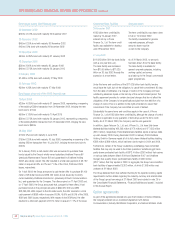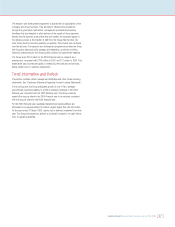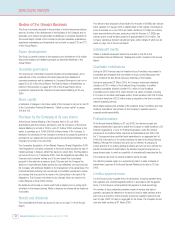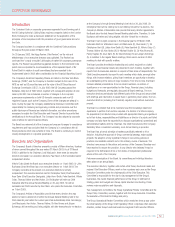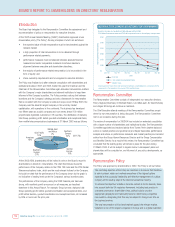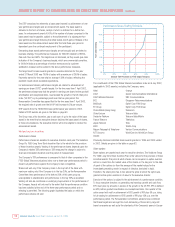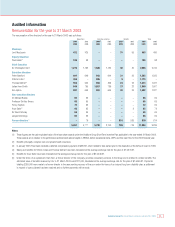Vodafone 2003 Annual Report Download - page 56
Download and view the complete annual report
Please find page 56 of the 2003 Vodafone annual report below. You can navigate through the pages in the report by either clicking on the pages listed below, or by using the keyword search tool below to find specific information within the annual report.
Vodafone Group Plc Annual Report & Accounts and Form 20-F 2003
54
CORPORATE GOVERNANCE Continued
This Committee is responsible for the operational performance and achievement
of targets of the Group’s business, with a focus on the enhancement of voice
services and growth of non-voice services, new global products and services,
brand development, technology and other cost and revenue synergies within the
Group’s regions.
The Group Policy Committee, which meets eight times each year, is chaired by
the Chief Executive. The Financial Director and the Group Chief Operating Officer,
together with certain other Group functional heads, join him on the Committee,
which is responsible for the determination of policy and the monitoring of non-
operational areas of activity which are important to the Group overall, including
strategy, finance, human resources, legal, regulatory and corporate affairs.
Committees of the Board
The standing Board committees are the Audit Committee, the Nominations
Committee and the Remuneration Committee. The Constitution and terms of
reference of these committees are published on the Company’s website at
www.vodafone.com.
The Audit Committee, which met on five occasions in the year, is comprised of
financially literate members having the necessary ability and experience to
understand financial statements. The Committee is chaired by Paul Hazen (5)
and the other members of the Committee are Dr Michael Boskin (5), Dr John
Buchanan and Sir David Scholey (5). Arun Sarin (4) served on the Committee
during the year and resigned on 1 April 2003. Dr Buchanan joined the
Committee on 1 April 2003.
Under its terms of reference the Committee is required, amongst other things, to
oversee the relationship with the external auditors, to review the Company’s
preliminary results, interim information and annual financial statements, to monitor
compliance with statutory and listing requirements for any exchange on which the
Company’s shares are quoted, to review the scope, extent and effectiveness of
the activity of the Group Internal Audit Department and to investigate any activity
within its terms of reference. At least twice a year the Audit Committee meets
separately with the external auditors and the Group Audit Director without
management being present. Further details on the oversight of the relationship
with the external auditors can be found under “Auditors”on page 52.
The Nominations Committee met five times in the year and is chaired by Lord
MacLaurin (5). The other members of the Committee are Sir Alec Broers (5), Sir
Christopher Gent (5), Sir David Scholey (5) and Jürgen Schrempp (3). Paul Hazen
joined the Committee on 1 April 2003. The Committee, which provides a formal
and transparent procedure for the appointment of new directors to the Board,
generally engages external consultants to advise on prospective Board
appointees. This year, the Committee has been faced with the need to appoint a
new Chief Executive and has also recommended the appointment of a further
non-executive director. In both cases, detailed job profiles were agreed by the
Committee before external search consultants were engaged to prepare
shortlists of potentially suitable candidates. Only after a rigorous interview
process were the appointments recommended to the Board.
The Remuneration Committee met six times in the year. The Committee is
chaired by Penny Hughes (6). The other members of the Committee are Lord
MacLaurin (6), Sir David Scholey (6), Dr Michael Boskin (4) and Jürgen
Schrempp (5). The Board’s Report to Shareholders on Directors’ Remuneration
on pages 56 to 66 provides further information on this Committee.
Attendance is shown in parenthesis after each respective Committee member.
Internal Control and Disclosure Controls and
Procedures
Introduction
The Board has established procedures that implement in full the Turnbull
Guidance, “Internal Control: Guidance for Directors on the Combined Code”,for
the year under review and to the date of approval of the Annual Report. These
procedures, which are subject to regular review, provide an ongoing process for
identifying, evaluating and managing the significant risks faced by the Group.
Responsibility
The Board has overall responsibility for the system of internal control. A sound
system of internal control is designed to manage rather than eliminate the risk of
failure to achieve business objectives, and can only provide reasonable and not
absolute assurance against material misstatement or loss. The process of
managing the risks associated with social, environmental and ethical impacts is
discussed under “Corporate Social Responsibility”, below.
Control structure
The Board sets the policy on internal control that is implemented by
management. This is achieved through a clearly defined operating structure with
lines of responsibility and delegated authority. The Group Executive Committee,
chaired by the Chief Executive, manages this on a day-to-day basis.
Written policies and procedures have been issued which clearly define the limits
of delegated authority and provide a framework for management to deal with
areas of significant business risk. These policies and procedures are reviewed
and, where necessary, updated at the Group Policy Committee meetings, chaired
by the Chief Executive.
Control environment
The Group’s operating procedures include a comprehensive system for reporting
information to the directors. This system is properly documented and regularly
reviewed.
Budgets are prepared by subsidiary management and subject to review by both
regional management and the directors. Forecasts are revised on a quarterly
basis and compared against budget. When setting budgets and forecasts,
management identifies, evaluates and reports on the potential significant
business risks.
The Group Operational Review Committee and the Board review management
reports on the financial results and key operating statistics.
Emphasis is placed on the quality and abilities of the Group’s employees with
continuing education, training and development actively encouraged through a
wide variety of schemes and programmes. The Group has adopted a set of
values to act as a framework for its people to exercise judgement and make
decisions on a consistent basis.
Directors are appointed to associated undertakings and joint ventures and attend
the board meetings and review the key financial information of those
undertakings. Clear guidance is given to those directors on the preparation that
should take place before these board meetings and their activity at the board
meeting. It is the Group’s policy that its auditors are appointed as auditors of
associated companies and joint ventures, where possible.
The acquisition of any business requires a rigorous analysis of the financial and
operational implications of the acquisition. A sensitivity analysis takes place of


